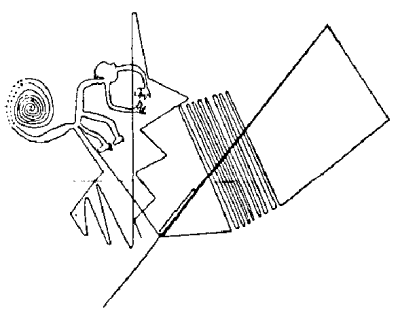 |
Science Frontiers ONLINE No. 47: Sep-Oct 1986 |
|
|
Explaining The Nazca Lines
The Nazca lines of Peru have been one of archeology's more enduring anomalies. Books have been written about them; theories abound; what more can be said? Evidently there is more.
A.F. Aveni's recent article in Archaeology sets the Nazca lines in perspective and adds some new observations. First, Aveni deflates their mystery a bit. You do not have to be in an airplane to appreciate the lines; most can be viewed from ground level, even better from nearby foothills. Although there are some 1,300 kilometers of lines and about 300 geometric figures, their construction did not really involve much labor or special engineering skills. Even so, the Nazca lines are remarkable, and we really do not know for certain why they were etched on the Peruvian pampa.
In his early research on the Nazca lines, Aveni noted their strong similarity to the ceque system of 41 imaginary lines radiating outwards from the Inca's Temple of the Sun, at Cuzco -- the "navel" of the Inca universe.
"...the ceque system was a highly ordered hierarchical cosmographical map, a mnemonic scheme that incorporated virtually all important matters connected with the Inca world view."
Could the Nazca lines have been a forerunner of the ceque system? Aveni also noticed that the Nazca lines and geometrical figures were closely related to watercourses. Also, many of the lines definitely functioned as footpaths. It was also apparent that the animal figures, which were laid down much earlier than the line systems, were not related conceptually to the line scheme.
Aveni concluded:
"...whatever the final answer may be to the mystery of the Nazca lines, this much is certain: the pampa is not a confused and meaningless maze of lines, and it was no more intended to be viewed from the air than an Iowa wheat field. The lines and line centers give evidence of a great deal of order, and the well-entrenched concept of radiality offers affinities between the ceque system of Cuzco and the lines on the pampa. All the clues point to a ritual scheme involving water, irrigation and planting; but as we might expect of these ancient cultures, elements of astronomy and calendar were also evident."
(Aveni, Anthony F.; "The Nazca Lines: Patterns in the Desert," Archaeology, 39:33, August 1986.)
Reference. For more on the Nazca lines and other "geoglyphs," see our handbook Ancient Man, which is described here.
 | Monkey effigy and geometric patterns in the Nazca line complex, Peru. |